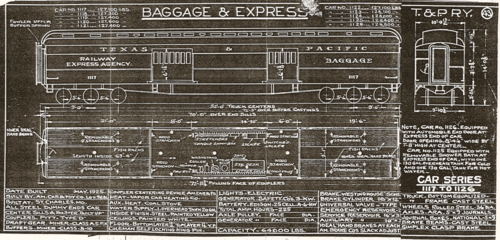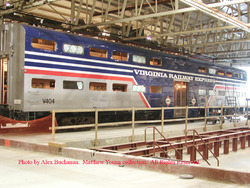The Problem of Color: Paint Matching
 Thursday, January 27, 2011 at 04:24PM
Thursday, January 27, 2011 at 04:24PM - Paint on the real railroad rolling stock changes over time. Newly applied paint looks different than paint that has been weathered. The paint formula itself may also change over time. For instance, Norfolk & Western "Tuscan Red" paint changed around 1958. It went from a tomato soup red to a more maroon red.
- Variation in reference points. Unless you are modeling a brand new diesel locomotive, you'll be basing the paint samples on equipment that has been retired . . . not exactly newly painted. Also, Pullman green for Great Northern may not be the same as Pullman green on other railroads. Remember this was before computerized color matching as we have in modern auto body shops. If you're basing your color on a picture, photographs of painted rolling stock will also introduce variation, based on lighting condition and surroundings. A car photographed under the noon-day sun will look different than one taken in the late afternoon. The advent of computers has not always resulted in more precision: a JPG image on your computer screen will vary according to the monitor's color settings. An image found online may look accurate, but hue, tone and intensity are easily, and often, changed with programs like Adobe Photoshop. Such an image may only meet the standard of "what looks good" in the eyes of the poster.
- Popular understanding. Popular railroad culture may perpetuates an image which isn't accurate. For example, the Atlantic Coast Line green heavyweight baggage cars appear to have always had black roofs, since most of the available images are from the 1960s. But this doesn't paint an accurate picture. For the record, ACL HW baggage cars prior to the 60's had roofs that matched the color of their carbody. In another example, the Kato SP Daylight painted train set is Kato's interpretation of a prototype's original color. Should another model train manufacturer match Kato's paint, stripe and lettering so the hobbyist can couple together cars from different manufacturers? Or should a modeler strive to match the original, even if the result is clashing models?
- Paint and inks. Paint on prototype metal differs from paint for plastic hobby models. Today it's common for model train manufacturers to specify color with Pantone color specs. In fact, the Union Pacific Railroad actually specifies their car paint by Pantone color specs. The Pantone system specifies inks by a color index, allowing for standardization. However, Pantone specs are intended for printing and web publishing and not for plastic surfaces. Hue, tone, and intensity all differ on a printed material when compared to a painted surface. Replicating the color from a printed image on plastic is very difficult.
- Substrate and painting. Pad printing inks over a darker painted surface can become a problem. For instance, "dulux" lettering applied over a Pullman green paint will look different than over a maroon painted surface. The real railroads didn't have this problem. Also, the hue, tone and intensity of the color depends on a number of factors: how the paint was applied, what percentage it was thinned to be sprayed, the pressure of the sprayer, the surface texture of the object, and the number of coats or applications. Furthermore, when the factory matches our paint chip samples, the matching is dependent on a technician's knowledge and experience of the paint being used and their perception of color.
- Lights and scale. Since the color that we see is created by reflection of light off of pigment, lighting conditions matter. Model railroad layouts are usually not lit by daylight but illuminated by fluorescents, LEDs or incandescent bulbs. A yellow or bluish cast makes your painted models look different. Further, objects that look "normal" on larger scale, may look too dark on smaller scale.
Now, what would be ideal to help a model train manufacturer in finding paint matches for a specific prototype? I wish the various railroad historical societies could provide paint samples (on plastic!) for the various elements of their specific rail systems . . . that would go a long way.
 Atlantic Coast Line,
Atlantic Coast Line,  Color,
Color,  Painting,
Painting,  Union Pacific |
Union Pacific |  Email Article
Email Article Notes from the Field
 Tuesday, December 28, 2010 at 08:32PM
Tuesday, December 28, 2010 at 08:32PM An enjoyable aspect of working here at Wheels of Time is documenting the prototype accurately. I am especially aware of the little details, details you'll see reflected on your Wheels of Time products. I find it especially satisfying when I find the prototype in real life. It certainly helps me develop accurate models! Here are some tips that I've learned in documenting a prototype.
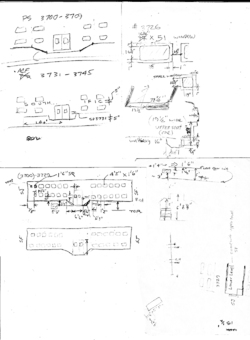 1) Take good field notes, even if it looks like chicken scratch. Here are my field notes for the SP American Car & Foundry bilevel coach built in 1957. You never find this level of detail from a magazine drawing. Taking good notes, I see things that otherwise I would miss. One such detail: the 1955 Pullman-Standard cars had wide shallow skirts around the center doors and slightly angled in A/C diesel-generator cabinet, in contrast to the ACF coaches.
1) Take good field notes, even if it looks like chicken scratch. Here are my field notes for the SP American Car & Foundry bilevel coach built in 1957. You never find this level of detail from a magazine drawing. Taking good notes, I see things that otherwise I would miss. One such detail: the 1955 Pullman-Standard cars had wide shallow skirts around the center doors and slightly angled in A/C diesel-generator cabinet, in contrast to the ACF coaches.
2) Use a measuring stick. It makes taking general dimensions easier since it will not flex or roll up like a measuring tape. It can give the relative scale of complex parts. My stick is a 3-ft PVC pipe with electrical tape, marked off at 3" and 1' increments.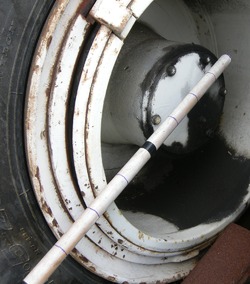
3) A measuring tape is also a must for accurate dimensioning. Here is a measuring tape in relation to a PCC truck. I'm careful to measure how far things stick out.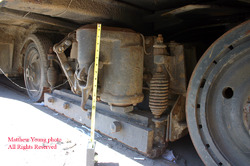
4) Documenting the style, color, dimensions of the actual lettering is important. This one is from a B & O car.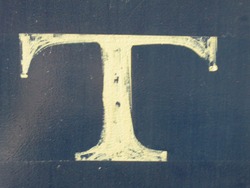
5) Paint color can vary under different lighting conditions. Here is a VRE bilevel coach in the railroad shop. Having photos of the paint scheme in white lighting conditions can be helpful in finding the correct hue of the paint.
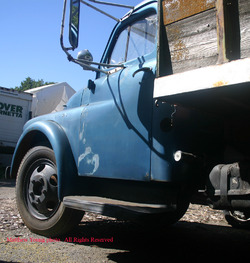
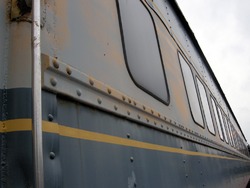
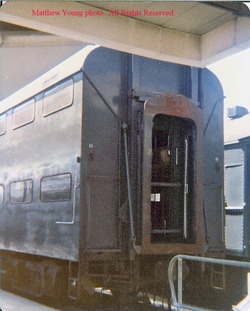
5:15 PM Train Time (A Photo Essay)
 Wednesday, December 22, 2010 at 03:52PM
Wednesday, December 22, 2010 at 03:52PM Etched into memory forever is the oscillating flash of the locomotive’s light, the hiss of air, the sound of tickets being punched, the clickety-clack of the rails, the sing-song call of the next stop, the squeal of brakes, a sea of humanity carried through the peak hours by a parade of 7- to 10-car trains. The commuter remembers the distinctive throb of the Fairbanks-Morse OP engine bringing us up to speed, the chant of the EMD 16-cylinder 567 prime mover ... even the sterile turbocharged whine of the EMD 20-cylinder 645. Watch your step! All aboard! Enjoy your ride into history. (And remember to reserve your set of bilevel commute coaches by 12/28/10.)
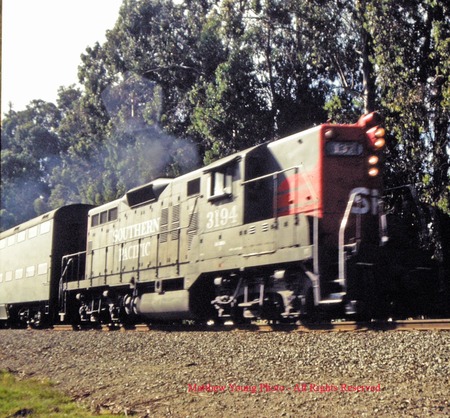 GP-9 accelerating out of Burlingame during the morning rush hour
GP-9 accelerating out of Burlingame during the morning rush hour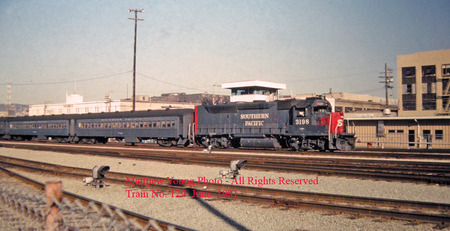 Morning, June 1981, Train No. 129 enters 4th & Townsend with EMD GP40P-2 leading a train of 72-ft Suburban Coaches
Morning, June 1981, Train No. 129 enters 4th & Townsend with EMD GP40P-2 leading a train of 72-ft Suburban Coaches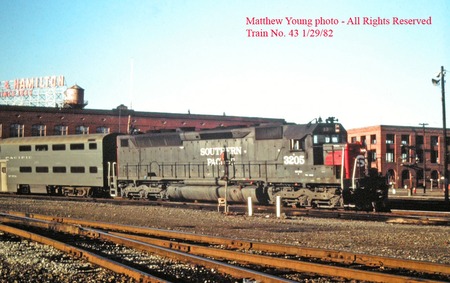 Morning train No. 43 rounding the curve for the last lap into the City ... bilevel coach shown is a 1968 Pullman-Standard built car
Morning train No. 43 rounding the curve for the last lap into the City ... bilevel coach shown is a 1968 Pullman-Standard built car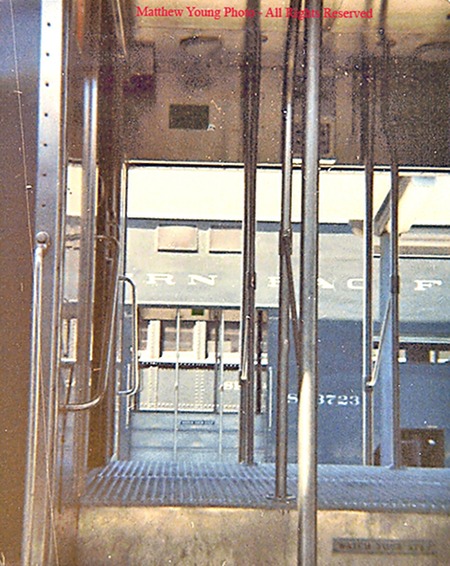 This was taken when I was a little with my 110 Kodak Instamatic Camera: Car No. 3723 is an ACF built 1957 bilevel coach that Wheels of Time is currently recreating (see http://wheelsotime.com/bilevel-commute-coach)
This was taken when I was a little with my 110 Kodak Instamatic Camera: Car No. 3723 is an ACF built 1957 bilevel coach that Wheels of Time is currently recreating (see http://wheelsotime.com/bilevel-commute-coach)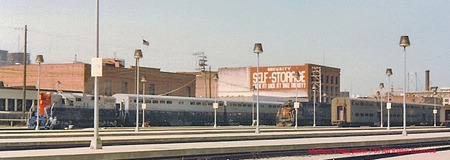 One of a kind Caltrain-painted-&-leased SP locomotive 3187 with bilevel coaches leaving in the afternoon
One of a kind Caltrain-painted-&-leased SP locomotive 3187 with bilevel coaches leaving in the afternoon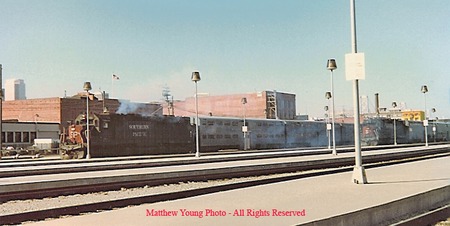 Evening rush hour with SDP45 in command
Evening rush hour with SDP45 in command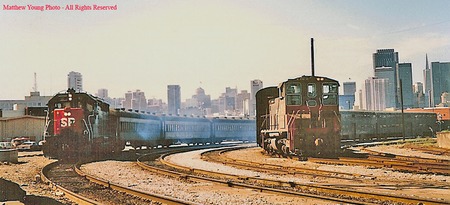 SP Train No. 42 rounding 7th Street with EMD SW1500 switching a set of bilevel coaches
SP Train No. 42 rounding 7th Street with EMD SW1500 switching a set of bilevel coaches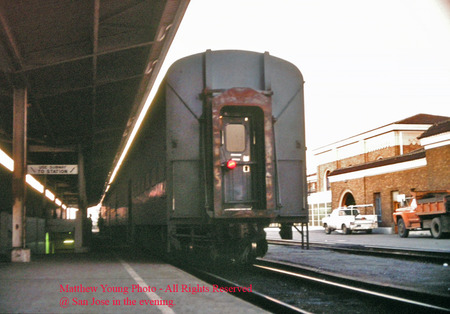 Train No. 151 at San Jose waiting to leave for a night run up the Peninsula ... notice the portable red light that hangs on the metal gate
Train No. 151 at San Jose waiting to leave for a night run up the Peninsula ... notice the portable red light that hangs on the metal gate
SHIPPING & UPDATE
 Tuesday, December 7, 2010 at 11:45AM
Tuesday, December 7, 2010 at 11:45AM We are shipping our 70-ft heavyweight baggage-express cars through next week. They look really nice. Yours truly is packing the orders. Our ADA Station Platform Warning Bands in HO- and N-scales are being made. Be sure to check out the bilevel commute coaches (reservations due at your dealer or direct by Dec. 28th). These bilevels will have really fine printing and painting with two-level seating, like the real thing.

